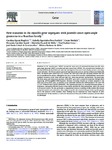Use este identificador para citar ou linkar para este item:
http://www.alice.cnptia.embrapa.br/alice/handle/doc/974829Registro completo de metadados
| Campo DC | Valor | Idioma |
|---|---|---|
| dc.contributor.author | DIAS-LOPES, C. | pt_BR |
| dc.contributor.author | NESHICH, I. A. P. | pt_BR |
| dc.contributor.author | NESHICH, G. | pt_BR |
| dc.contributor.author | ORTEGA, J. M. | pt_BR |
| dc.contributor.author | GRANIER, C. | pt_BR |
| dc.contributor.author | CHÁVEZ-OLORTEGUI, C. | pt_BR |
| dc.contributor.author | MOLINA, F. | pt_BR |
| dc.contributor.author | FELICORI, L. | pt_BR |
| dc.date.accessioned | 2014-01-02T11:11:11Z | pt_BR |
| dc.date.available | 2014-01-02T11:11:11Z | pt_BR |
| dc.date.created | 2014-01-02 | pt_BR |
| dc.date.issued | 2013 | pt_BR |
| dc.identifier.citation | PLoS ONE, San Francisco, v. 8, n. 11, p. 1-12, 2013. | pt_BR |
| dc.identifier.isbn | 10.1371/journal.pone.0079240 | pt_BR |
| dc.identifier.uri | http://www.alice.cnptia.embrapa.br/alice/handle/doc/974829 | pt_BR |
| dc.description | Sphingomyelinases D (SMases D) or dermonecrotic toxins are well characterized in Loxosceles spider venoms and have been described in some strains of pathogenic microorganisms, such as Corynebacterium sp. After spider bites, the SMase D molecules cause skin necrosis and occasional severe systemic manifestations, such as acute renal failure. In this paper, we identified new SMase D amino acid sequences from various organisms belonging to 24 distinct genera, of which, 19 are new. These SMases D share a conserved active site and a C-terminal motif. We suggest that the C-terminal tail is responsible for stabilizing the entire internal structure of the SMase D Tim barrel and that it can be considered an SMase D hallmark in combination with the amino acid residues from the active site. Most of these enzyme sequences were discovered from fungi and the SMase D activity was experimentally confirmed in the fungus Aspergillus flavus. Because most of these novel SMases D are from organisms that are endowed with pathogenic properties similar to those evoked by these enzymes alone, they might be associated with their pathogenic mechanisms. | pt_BR |
| dc.language.iso | eng | eng |
| dc.rights | openAccess | eng |
| dc.subject | Bioinformática | pt_BR |
| dc.subject | Esfingomielinas | pt_BR |
| dc.subject | Enzimas | pt_BR |
| dc.title | Identification of new Sphingomyelinases D in pathogenic fungi and other pathogenic organisms. | pt_BR |
| dc.type | Artigo de periódico | pt_BR |
| dc.date.updated | 2014-01-02T11:11:11Z | pt_BR |
| dc.subject.nalthesaurus | Bioinformatics | pt_BR |
| dc.subject.nalthesaurus | Sphingomyelins | pt_BR |
| dc.subject.nalthesaurus | Enzymes | pt_BR |
| riaa.ainfo.id | 974829 | pt_BR |
| riaa.ainfo.lastupdate | 2014-01-02 | pt_BR |
| dc.contributor.institution | CAMILA DIAS-LOPES, UFMG; IZABELLA A. P. NESHICH, Unicamp; GORAN NESHICH, CNPTIA; JOSÉ MIGUEL ORTEGA, UFMG; CLAUDE GRANIER, SysDiag UMR 3145 CNRS/BioRad; CARLOS CHÁVEZ-OLORTEGUI, UFMG; FRANCK MOLINA, SysDiag UMR 3145 CNRS/BioRad; LIZA FELICORI, UFMG. | pt_BR |
| Aparece nas coleções: | Artigo em periódico indexado (CNPTIA)  | |
Arquivos associados a este item:
| Arquivo | Descrição | Tamanho | Formato | |
|---|---|---|---|---|
| SphingomyelinasesD.pdf | 1,25 MB | Adobe PDF |  Visualizar/Abrir |









